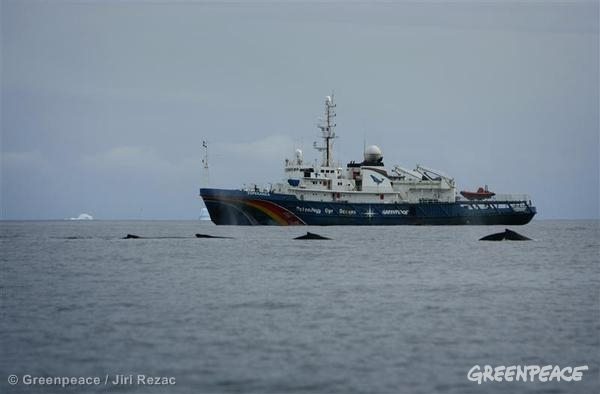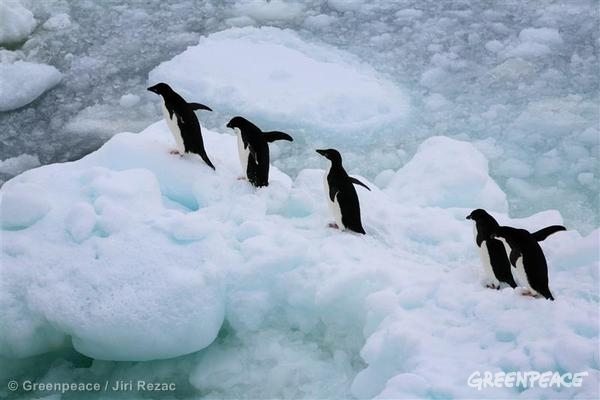Blogpost by Richard Page
Oceans campaigner Richard Page is currently attending the annual meeting of CCAMLR Commission, where discussions are underway for a representative network of marine protected areas across the Southern Ocean by 2012.
Although it’s spring here in Hobart, Tasmania, the sometimes-chilly weather reminds me that there is only 3,500km (2000 miles) of ocean between where I am and Antarctica. The city has strong connections with the icy continent at the bottom of our blue planet. James Clark Ross and Roald Amundsen are just two of the famous polar explorers whose expeditions stopped in Hobart on the way south. Today, Tasmania is no less important to Antarctic research and is home to the Australian Antarctic Division and importantly, the secretariat for the Convention for the Conservation of Marine Living Resources (CCAMLR) is based here too. And this is where the negotiations on the Southern Ocean marine reserves take place, crucial for the future of these pristine waters.
In the early 1980s there were growing concerns that an increase in krill catches in the Southern Ocean could have a serious effect on populations of krill and the many species, such as penguins, petrels, seals and fish that depend on this shrimp-like crustacean for food. As a result, CCAMLR was negotiated and came into force in 1982, with aims conserve the marine life and manage the fisheries of the Southern Ocean. Those who negotiated the Convention text broke new ground, by agreeing to strong rules and the requirement to take precautionary action if there is a possibility that fishing puts the wider ecosystem at risk. There are crucial rules in the Convention that enable the establishment of marine reserves and marine protected areas in the Southern Ocean, which distinguish them from the Arctic Ocean and most of the rest of the high seas, where such rules are totally absent, leaving them open to plunder.
In the subsequent decades, the remote waters of the Southern Ocean have come under increasing pressure with climate change, ocean acidification and commercial fisheries all threatening the fragile Antarctic ecology. Over the next weeks, possibly as many as 18 vessels from seven countries, including New Zealand, the UK and Korea, will be heading to the Ross Sea to fish for toothfish, which is sold as Chilean Sea Bass in some countries. The long-lived and slow growing Antarctic toothfish is an important component of the Ross Sea ecosystem, and is thought to play a similar role to that of sharks in warmer waters. Unlike most ocean ecosystems, the Ross Sea still maintains its full complement of top predators, being home to vast populations of Antarctic petrels, emperor penguins, Adelie penguins, Weddell seals and minke whales. It is also home to Ross Sea type-C killer whales, a distinct species that feeds on toothfish and my own personal favorite, the colossal squid. It seems incredible to me that fishermen are going literally to the end of the earth to work in such freezing and dangerous conditions. The truth is that this fishery simply wouldn’t be economic if so many fish stocks in near-shore waters hadn’t been massively overfished.
Last week was the final day of the 30th annual meeting of CCAMLR Commission, where countries have been discussing plans to establish a representative network of marine protected areas across the Southern Ocean by 2012. I was there to follow negotiations and lobby country officials on the need to establish a circum-polar network of marine reserves that will afford the scale and level of protection that is needed. I am pleased to say that I was not alone. The meeting period saw the launch of the newly formed Antarctic Oceans Alliance, a joint initiative supported by ASOC (Antarctic and Southern Ocean Coalition), Mission Blue, Last Ocean, Oceana, Oceans Five, Forest and Bird and ECO as well as Greenpeace. The aim is ambitious — to ensure the creation of a network of Southern Ocean marine reserves, at least in an order of magnitude larger than anything established so far.
While I have no illusions that it’s going to be easy, it’s a great team of people from across the environmental and oceans NGOs, many of whom I’ve worked with over the years, some of whom at one time or another sailed on the good ship Greenpeace. Over the next months and years, let us hope CCAMLR distinguishes itself by living up to the expectations of those who worked for its creation and sets the benchmark for the conservation of marine life of the high seas by establishing a large-scale network of marine reserves that includes the entire Ross Sea.
Photo: Humpback whales beside the Greenpeace ship Esperanza, in the Southern Ocean, and Adelie penguins in the Southern Ocean. Photos: Jiri Rezac/Greenpeace
TAKE ACTION: Join the campaign to protect the oceans around the Antarctica.




